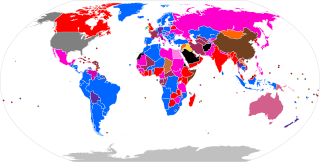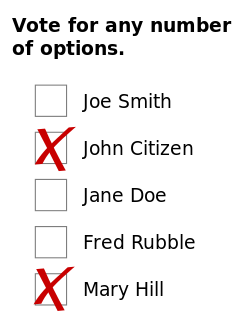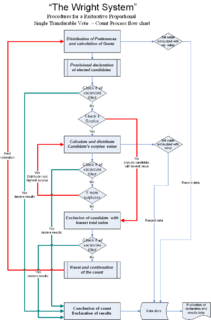 W
WAn electoral system or voting system is a set of rules that determine how elections and referendums are conducted and how their results are determined. Political electoral systems are organized by governments, while non-political elections may take place in business, non-profit organisations and informal organisations. These rules govern all aspects of the voting process: when elections occur, who is allowed to vote, who can stand as a candidate, how ballots are marked and cast, how the ballots are counted, how votes translate into the election outcome, limits on campaign spending, and other factors that can affect the result. Political electoral systems are defined by constitutions and electoral laws, are typically conducted by election commissions, and can use multiple types of elections for different offices.
 W
WApproval voting is an electoral system where each voter may select ("approve") any number of candidates, and the winner is the candidate approved by the largest number of voters. It is distinct from plurality voting, in which a voter may choose only one option among several, whereby the option with the most votes is chosen. It is related to score voting in which voters give each option a score on a scale, and the option with the highest total of scores is selected. Approval voting can also be used in multiwinner elections; see multiwinner approval voting.
 W
WBlackballing is a rejection in a traditional form of secret ballot, where a white ball or ballot constitutes a vote in support and a black ball signifies opposition. The system is typically used where an organization's rules provide that one or two objections, rather than an at-least-50% share of votes, are sufficient to defeat a proposition. Since the seventeenth century, these rules have commonly applied to elections to membership of many gentlemen's clubs and similar institutions such as Masonic lodges and fraternities.
 W
WCardinal voting refers to any electoral system which allows the voter to give each candidate an independent evaluation, typically a rating or grade. These are also referred to as "rated", "evaluative", "graded", or "absolute" voting systems. Cardinal methods and ordinal methods are two main categories of modern voting systems, along with plurality voting.
 W
WCondorcet efficiency is a measurement of the performance of voting methods. It is defined as the percentage of elections for which the Condorcet winner is elected, provided there is one.
 W
WThe effective number of parties is a concept introduced by Laakso and Taagepera (1979) which provides for an adjusted number of political parties in a country's party system. The idea behind this measure is to count parties and, at the same time, to weight the count by their relative strength. The relative strength refers to their vote share or seat share in the parliament. This measure is especially useful when comparing party systems across countries, as is done in the field of political science. The number of parties equals the effective number of parties only when all parties have equal strength. In any other case, the effective number of parties is lower than the actual number of parties. The effective number of parties is a frequent operationalization for the fragmentation of a party system.
 W
WAn election apportionment diagram is the graphic representation of election results and the seats in a plenary or legislative body. The chart can also be used to represent data in easy to understand terms, for example by grouping allied parties together.
 W
WThe Gallagher index is a statistical analysis methodology utilised within political science which "measures an electoral system’s relative disproportionality between votes received and seats allotted in a legislature." As such, it measures the difference between the percentage of votes each party gets and the percentage of seats each party gets in the resulting legislature, and it also measures this disproportionality from all parties collectively in any one given election. That collective disproportionality from the election is given a precise score, which can then be used in comparing various levels of proportionality among various elections from various electoral systems.
 W
WHare-Clark is a type of single transferable vote electoral system of proportional representation used for elections in Tasmania and the Australian Capital Territory. The method for the distribution of preferences is similar to other voting systems in Australia, such as for the Australian Senate.
 W
WThe matrix vote is a voting procedure which can be used when one group of people wishes to elect a smaller number of persons, each of whom is to have a different assignment. Examples of its use arewhen an association elects its executive committee; and when a parliament elects its all-party power-sharing coalition government.
 W
WNational remnant was a former election system used in 1965 elections in Turkey. In 1965 Turkey had 67 electoral districts all of which were provinces of Turkey. The system was developed to support smaller parties which were unable to gain enough votes in an electoral district to gain a seat.
 W
WCardinal voting refers to any electoral system which allows the voter to give each candidate an independent evaluation, typically a rating or grade. These are also referred to as "rated", "evaluative", "graded", or "absolute" voting systems. Cardinal methods and ordinal methods are two main categories of modern voting systems, along with plurality voting.
 W
WThe single transferable vote (STV) is a voting system designed to achieve or closely approach proportional representation through the use of multiple-member constituencies and each voter casting a single ballot on which candidates are ranked. The preferential (ranked) balloting allows transfer of votes to produce proportionality, to form consensus behind select candidates and to avoid the waste of votes prevalent under other voting systems. Another name for STV is multi-winner ranked-choice voting.
 W
WSocial utility efficiency (SUE) is a measurement of the utilitarian performance of voting methods—how likely they are to elect the candidate who best represents the voters' preferences.
 W
WThreeBallot is a voting protocol invented by Ron Rivest in 2006. ThreeBallot is an end-to-end (E2E) auditable voting system that can in principle be implemented on paper. The goal in its design was to provide some of the benefits of a cryptographic voting system without using cryptographic keys.
 W
WThe Wright system is a refinement of rules associated with proportional representation by means of the single transferable vote (PR-STV) electoral system. It was developed and written by Anthony van der Craats, a system analyst and life member of the Proportional Representation Society of Australia. It is described in a submission into a parliamentary review of the 2007 Australian federal election.